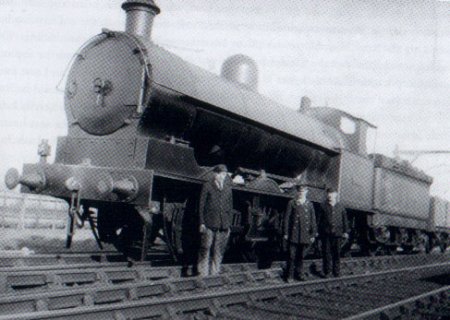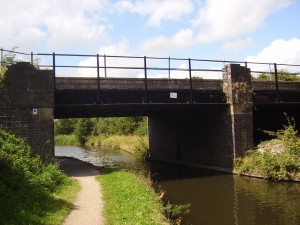Norton Junction to Norton Collieries Railway
The first sidings at Ryders Hayes, consisted of 5 lines running parallel to the Walsall to Lichfield line. These were used as holding sidings, to accomodate the coal from the various Pelsall coalfields, and goods from Pelsall Ironworks. On April 25th 1879, a double track branch line was opened, from the Walsall / Lichfield line at Ryders Hayes, to Norton Canes, and a single track line then carried on to Hednesford. This line was to connect with the number of collieries in the Norton Canes, and Cannock Chase coalfields. As the coal traffic increased, more sidings were added at Ryders Hayes, until the area grew into the large complex, known as, Norton Junction Marshalling Yard. The yard finally closed to coal traffic in 1964.
Norton Junction was mainly used as a marshalling yard, for the coalfields of Norton Canes, Cannock Chase, and Walsall Wood Colliery. Trains of laden coal wagons arrived at the junction from the coal mines, and were sorted into groups, before continuing their journey, via the main Walsall to Lichfield line, which was directly connected to the junction

Norton Junction on a busy day, showing the lines of re-arranged wagons

Norton Junction showing the number of sidings.

Looking towards the Pelsall Road, facing the line to Norton Canes.

Norton Junction today, grass where the old track beds used to be.
The method of sorting or shunting, carried out at Norton Junction was known as Hump Shunting. At the entrance to the yard, there was a slight downhill gradient, sufficient for the wagons to roll freely. The coal wagons were coupled together with just a 3 link chain,and termed ”loosed coupled”. The engine slowly pushed the string of wagons towards the top of the gradient, and the man on the ground, called a shunter, disconnected the coupling chain of one or more wagons, using a long wooden pole with a hook on the end

Shunter’s pole used to disconnect the coupling chains on the coal wagons.
Gravity then came into play and the wagons began their descent down the incline. The operative in the signal box adjusted the point system, to allow the rolling wagons to enter the appropriate siding, so as to make up new trains for nationwide distribution.The speed of these free running wagons, was regulated by the shunter, who , whilst running along side the accelerating wagons, applied their brakes, using a wooden lever, which he inserted between the wagon body, and the top of the brake arm. He then applied downward force on the lever, which applied the brake directly onto the wagon wheel. This was an extremely dangerous manoeuvre, and would not be allowed to happen today, with the current HSE legislation. It also needed great skill and precise timing, to get the heavily laden wagons ,to come to rest in the exact location, without crashing into the stock already in the sidings.

Shunter’s brake lever, the square section was inserted under the wagon body and the shunter applied downward force on the round section.

This photo shows the Lichfield Rd bridge. The slope is on the other side of the bridge, and the wagons rolled under the bridge, towards the signal box, which was used to divert the moving wagons to the correct siding.

The super D steam locomotive was the most popular shunting engine, until it was replaced by diesel traction in 1948.

A typical heavy diesel shunting locomotive which was used by British Railways after the demise of steam power
The line to the Norton Canes Collieries passed under the Lichfield Road bridge, parallel with the Wyrley and Essington Canal. After passing over a bridge to the farmers fields, the line crossed the canal at the Slough, where the waterway turned East.

Crossing the canal at the Slough, the arch to the right was for Big House farm ( Howdle’s) to access the fields which reached as far as Lime lane in Pelsall.

The Slough bridge taken from the top, the lower section and the outside handrails, are from the original bridge construction. The inner handrails, and the upper reinforced concrete section, were added after the Norton branch line closed to rail traffic in 1964. In between the Norton branch closing, and the closure of the Walsall to Lichfield line, Leigh Environmental, trading as Effluent Disposal, used the track bed from the level crossing in Engine lane, down to Norton Junction. After the rail removal, and strengthening of the Slough bridge, large articulated tankers from Effluent Disposal, entered Norton Junction from Engine Lane. The purpose of this was to transfer vast quantities of waste chemicals from rail tankers, which had been collected nationwide and left in the sidings. After transferring the chemicals, the road tankers then drove to the site of the old Walsall Wood Colliery and emptied the chemicals, down the disused pit shaft.
Carrying on along the line towards Norton Canes, the next crossing was in Engine Lane. This was a gated level crossing for the use of the local farmers to access their fields.

Site where the level crossing used to be in Engine Lane

Track bed as it is today, looking towards Norton Junction, from Engine Lane. It’s hard to think that this used to be a busy two track railway line. Mother Nature soon reclaims her own.
About 100 yards past the level crossing towards Norton, was a signal box. This box controlled the crossing gates, signals and a set of points, giving access to the branch line for the Grove Colliery, which was in Lime Lane between Pelsall and Norton Canes.

Photo showing the track bed where the branch line to the Grove Colliery goes off to the left and the track bed to the right carries on to Norton Canes.
Carrying on towards Norton the line then passed under the A5 trunk Road, at the Rising Sun

Bridge under the A5 at the Rising Sun
Running parallel with the modern Wilkin housing estate, the redundant track bed, now reduced to a narrow footpath crosses Allbuts Road. A short distance from here a newly erected footbridge takes pedestrians over the recently constructed BNRR or M6 Toll road. Continuing in a gradual downward mode we arrive at Red Lion Lane. Directly opposite the footpath enters the large housing development, and then divides into different directions, serving various roads in the Norton Canes area. This relates to the way that the railway lines were diverted, to serve the many coal mines in this district,when they were all actively working.
January 28, 2013 at 3:07 pm |
I did not know that this site existed till my brother informed me and I am very glad that he did .My age now is 77 but although we now live in South Wales your site reminds me of the area where I grew up “Norton Canes” so thank you all very much. Ken Whitehouse.
June 30, 2013 at 12:58 pm |
I was born over the hill in Brereton but the colliery lines around the chase i remember well Walked or cycled Norton Canes Hednesford Cannock. Memories linger but thanks for them in pictures Gordon Evans from Portugal
March 23, 2020 at 12:10 am |
I lived in Railswood Drive next to the bridge that now leads to a tractor business, and can remember the numerous train movements to and from Norton Junction, sometimes my friends and I would watch the trains at a level crossing at the south end of the marshalling yard, many happy memories still linger, shame that there’s not many photos of this once busy area.